Why are Small Business Marketing Funnels Important (and How Can They Be Effectively Implemented and Optimized) For My Business?
Ever feel like you’re trying to catch rain with a sieve when it comes to your small business marketing? For a lot of busy business owners, that’s exactly what they experience with their marketing efforts.
But here’s a secret: it’s not about catching more rain; it’s about using a better tool. Enter the marketing funnel – your small business’s very own rain barrel.
See, it’s not just about collecting potential customers but guiding them on a journey from ‘Who the heck are you?’ to ‘Shut up and take my money!’
So, buckle up, folks. We’re about to dive headfirst into the world of small business marketing funnels.
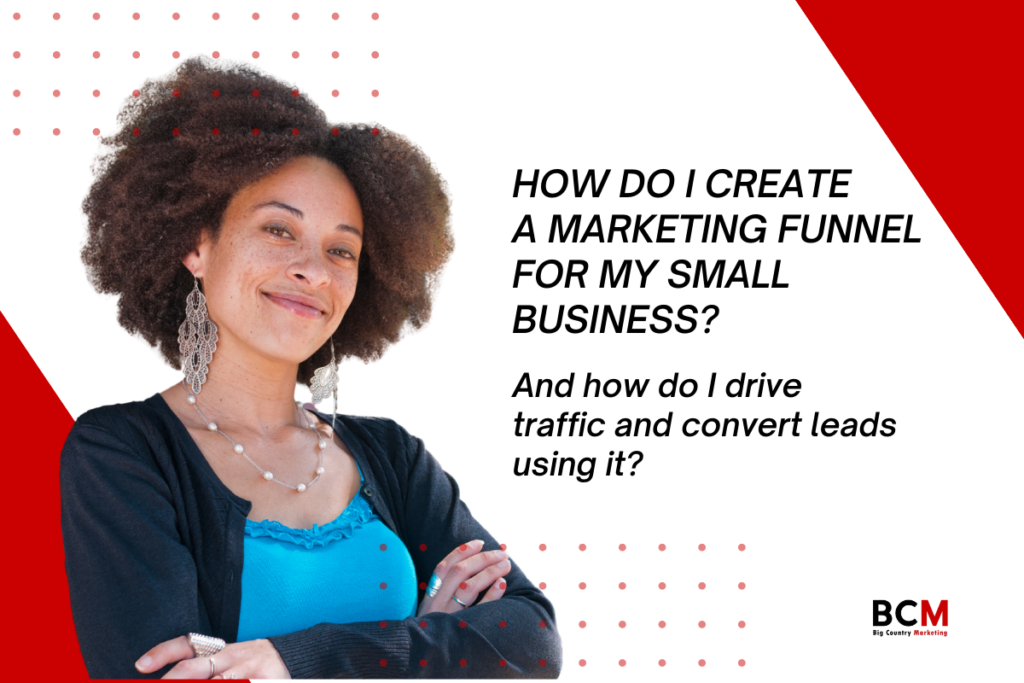
Navigating the labyrinth of marketing strategies can feel like a Herculean task for small businesses. The challenge is not just about attracting customers but also about converting them into loyal patrons.
According to HubSpot, 61% of marketers say generating traffic and leads is their top challenge. It’s a real problem; small businesses often struggle to maintain a steady stream of customers. A staggering 79% of marketing leads never convert into sales, with a lack of lead nurturing as the common cause.
This is a significant pain point, as it directly impacts the growth and sustainability of a business.
The situation can be further aggravated by the fact that acquiring a new customer can cost five times more than retaining an existing one.
Yet, many small businesses continue to pour their resources into broad-spectrum marketing strategies, often overlooking the potential of a well-structured marketing funnel.
But what if there was a more efficient way to attract, engage, and convert your audience? A method that could help streamline your marketing efforts and significantly improve your conversion rates?
Enter the world of small business marketing funnels, a strategic approach that could be the game-changer your business needs.
Small business marketing funnels are essential tools for attracting, engaging, and converting customers effectively. They provide a systematic approach to guide potential customers through your buying process, from awareness to purchase.
By understanding how to build and implement these funnels, avoiding common pitfalls, and measuring their success, small businesses can optimize their marketing efforts to drive growth and profitability.
Now, let’s talk about the magic of small business marketing funnels.
Picture this: you’re throwing a party, and you’ve got a list of guests you want to invite. You wouldn’t just send out a mass invite and hope for the best, right? You’d probably start with a friendly invitation, follow up with a reminder or two, and maybe even sweeten the deal with the promise of delicious food and great music.
That’s your party funnel, and it’s not too different from a marketing funnel.
In the realm of small business marketing, the funnel is your strategic party planner. It’s the process that helps you attract the right crowd (your target audience), engage them with compelling content (your cookies or your irresistible party vibe), and ultimately convert them into loyal customers (they’re at your party!).
Get it? In fact, if you throw a good enough party, they’ll tell others about how much of an awesome time they had. So now, not only are they looking forward to the next shindig, you also have more folks who’d want to be at the next gathering.
But the benefits don’t stop there. A well-structured marketing funnel not only helps you understand your customers’ journey but also allows you to identify potential bottlenecks and opportunities for improvement.
It’s like having a roadmap that guides your marketing efforts and helps you make data-driven decisions.
And the best part? Small business marketing funnels are not a one-size-fits-all solution. They can be tailored to fit your unique business needs and goals.
Whether you’re a local bakery looking to increase online orders or a digital marketing agency aiming to attract more clients, a marketing funnel can be your secret weapon to success.
Hang on. Why Should I Understand the Concept of a Marketing Funnel?
As a busy business owner, understanding the concept of a marketing funnel is crucial because it provides a framework for customer engagement, from the first point of contact to the final purchase and beyond.
It helps you visualize the customer journey, identify opportunities for engagement, and optimize your marketing strategies.
Fun fact: did you know that the concept of the marketing funnel has been around for over 100 years? Yet, it remains a critical piece of the marketing process, outlining the most straightforward journey customers might take on their path to purchase
Small business marketing funnels are like roadmaps, guiding potential customers from the moment they first hear about your business to the point where they become loyal advocates. But what exactly is this funnel, and why is it so important for small businesses?
The Stages of a Marketing Funnel
The marketing funnel can be broken down into four key stages: Awareness, Consideration, Conversion, and Loyalty. Each stage represents a different phase in the customer’s journey and plays a crucial role in moving them closer to making a purchase.
Stage 1: Awareness
This is the stage where potential customers first become aware of your brand. It’s all about attracting customers and helping them recognize and remember your brand.
The goal is to keep your brand top-of-mind, so that when the time comes for them to make a purchase, they think of you.
Stage 2: Consideration
At this stage, customers are trying to get to know your brand and discover what differentiates it from similar brands.
Your marketing messages should address a pain point, highlight an interest, or answer a question for consumers.
Stage 3: Conversion
Also referred to as the “decision” or “purchase” phase, this step is where you encourage shoppers to purchase your product or service because they believe your brand is the right solution to their problem.
Stage 4: Loyalty
The final stage of the funnel is all about turning customers into loyal advocates for your brand.
By providing a seamless purchase experience and delivering a quality product or service, you can foster loyalty and encourage repeat purchases.
Why Are Marketing Funnels Important?
While the customer journey may not be as linear as the simplified one expressed in the marketing funnel, the concept is still important.
The digital path to purchase is anything but linear, and the digital marketing funnel accounts for the fact that consumers enter and exit and move around the funnel.
Marketing funnels are also important for both lead generation and lead nurturing. In the awareness and consideration phases, brands use campaigns to attract new leads. In the decision and loyalty phases, brands use campaigns to nurture current leads and, eventually, help grow customers into brand advocates.
Funnels help you strategize your marketing efforts more effectively.
By understanding the funnel, you can ensure that you’re reaching potential customers at the right time with the right message, ultimately leading to increased conversions and customer loyalty.
See, it’s not just about making a sale; it’s about building long-term relationships with your customers, which is the key to sustainable business growth.
So, the next time you’re planning your marketing strategy, remember to consider your marketing funnel. It might just be the key to unlocking your business’s full potential.
How Can a Marketing Funnel Help My Small Business Grow?
If a marketing funnel is a tool to help businesses streamline the customer journey, then it makes it easier for potential customers to take desired actions.
It also allows businesses to track analytics easily, identify areas that need improvement, define a sales strategy, reduce costs, and increase revenues.
According to a report, businesses lose up to $1.6 trillion per year when customers leave them. And so, a well-structured marketing funnel can help prevent this loss by guiding customers through the stages of awareness, interest, decision, and action, thereby increasing customer retention and loyalty.
The Power of a Marketing Funnel
A marketing funnel can be a game-changer for small businesses. It helps in prioritizing marketing strategies, tracking customer journey stages, and identifying areas that need improvement.
By understanding the stages of a marketing funnel, businesses can create targeted marketing strategies that cater to potential customers at each stage, thereby increasing the chances of conversion.
Boosting Business Growth
A marketing funnel can significantly boost business growth by helping small businesses understand their customers better, create more effective marketing strategies, and ultimately convert more leads into customers.
You can guide potential customers more effectively through the stages of awareness, interest, decision, and action using your carefully crafted marketing funnel. This way, funnels help your small business turn prospects into loyal customers, thereby driving business growth.
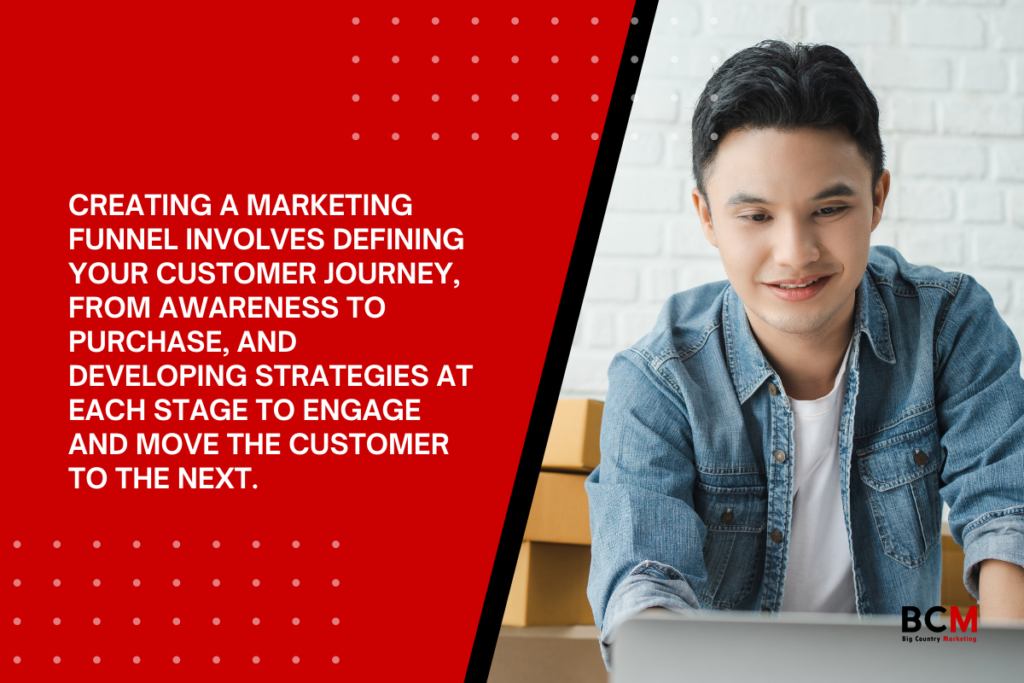
Creating a marketing funnel is a strategic process that requires a deep understanding of your customer’s journey. It’s a systematic approach to turning strangers into customers and, ultimately, brand advocates.
How Can I Build a Marketing Funnel for My Small Business?
Building a marketing funnel for your small business is like constructing a bridge to success. It’s not just about getting from point A to point B, but about enjoying the journey and making sure your customers do too.
According to a Forbes article, companies with simple, well-designed marketing funnels are 62% more likely to close high-quality sales. Now, who wouldn’t want that?
So here’s what you do:
Step 1: Define Your Customer Journey
First things first, you need to understand your customers. What are their needs, their pain points, and their desires? What steps do they take from the moment they first hear about your business to the moment they make a purchase?
This is your customer journey, and it’s the foundation of your marketing funnel.
Step 2: Review Your Funnel Stages
After defining your customer journey, it’s time to identify and understand the stages of your marketing funnel.
These stages align with the journey your customers take from first learning about your business to becoming loyal customers.
1. Awareness Stage:
This is the initial stage where potential customers first discover your business. At this point, you’re a new entity to them, so your goal is to capture their attention and make a positive first impression.
This could be through engaging content, social media presence, or even word-of-mouth referrals.
2. Consideration Stage:
At this stage, potential customers have developed an interest in your offerings and are actively seeking more information. They’re aware of their problem or need, and they’re considering your business as a possible solution.
Your goal here is to provide them with valuable content that educates them about your products or services and positions your brand as the best choice.
3. Conversion Stage:
This is the critical point where potential customers are ready to make a purchase. They’ve evaluated their options, and your product or service stands out as the best fit for their needs.
Your goal at this stage is to make the purchasing process as seamless as possible and to reassure them that they’re making the right decision.
4. Loyalty Stage:
The final stage of the funnel is not just about making a one-time sale. It’s about turning your customers into loyal advocates for your brand. They’ve made a purchase and had a positive experience with your product or service.
Now, your goal is to nurture this relationship, encourage repeat business, and inspire them to recommend your brand to others.
Remember, understanding these stages is crucial as it helps you to tailor your marketing strategies effectively at each stage, guiding your potential customers smoothly from one stage to the next.
Step 3: Develop Strategies for Each Stage
Now that you’ve identified the stages of your marketing funnel, it’s time to develop strategies for each stage. These strategies should be designed to guide potential customers from one stage to the next, ultimately leading them to make a purchase.
1. Awareness Stage:
The goal at this stage is to attract potential customers and make them aware of your brand. You can use various strategies such as:
- Content Marketing: Create valuable and relevant content that addresses the pain points of your target audience. This could be in the form of blog posts, articles, infographics, videos, podcasts, etc.
- Search Engine Optimization (SEO): Optimize your content with relevant keywords to improve your visibility on search engine results pages (SERPs). This can help attract organic traffic to your website.
- Social Media Marketing: Use platforms like Facebook, Instagram, LinkedIn, Twitter, etc., to reach out to your target audience. Regularly post engaging content to build your brand presence and attract followers.
- Paid Advertising: Use pay-per-click (PPC) advertising or social media ads to reach a wider audience. This can help increase your brand visibility and attract more potential customers.
2. Consideration Stage:
At this stage, potential customers are evaluating their options. Your goal is to nurture their interest and guide them toward choosing your product/service. Strategies include:
- Email Marketing: Send personalized emails with more detailed information about your products/services. You can also share useful content, special offers, etc., to keep them engaged.
- Webinars and Live Demos: Host webinars or live demos to showcase your products/services. This can help potential customers understand the value of your offerings.
- Retargeting Ads: Use retargeting ads to remind potential customers about your products/services. These ads are shown to people who have previously visited your website or interacted with your brand.
3. Conversion Stage:
Potential customers are ready to make a purchase at this stage. Your goal is to convince them that your product/service is the best choice. Strategies include:
- Testimonials and Case Studies: Share testimonials from satisfied customers or case studies showing the success of your products/services. This can help build trust and credibility.
- Product Comparisons and Reviews: Provide detailed comparisons of your products/services with competitors. Also, share positive reviews to influence their decision.
- Free Trials or Discounts: Offer free trials or discounts to encourage potential customers to try your products/services.
4. Loyalty Stage:
This is the final stage where you aim to turn customers into loyal advocates for your brand. Your goal is to keep them engaged and encourage repeat purchases. Strategies include:
- Customer Support: Provide excellent customer support to assist customers during and after the purchase process. This could include live chat support, FAQs, etc.
- Loyalty Programs: Implement loyalty programs that reward customers for repeat purchases. This could include discounts, freebies, or exclusive offers.
- Regular Communication: Keep in touch with your customers through regular newsletters, social media updates, or personalized emails. This helps to keep your brand top-of-mind and encourages repeat purchases.
Remember, the strategies you choose should align with your overall marketing goals and target audience. It’s also important to continuously monitor and adjust your strategies based on their performance.
Tips on Making Each Stage Effective
Remember, the goal of your marketing funnel is not just to make a sale, but to create a positive customer experience. This means providing value at every stage of the funnel, building trust with potential customers, and making it easy for them to move from one stage to the next.
Awareness Stage:
- Create engaging and informative content that resonates with your target audience. This could be blog posts, social media updates, videos, or podcasts.
- Utilize SEO strategies to increase your online visibility and attract more potential customers.
- Leverage social media platforms to reach a wider audience and engage with them on a personal level.
Consideration Stage:
- Provide detailed information about your products or services to help potential customers in their decision-making process.
- Use email marketing to nurture leads, providing them with valuable content and keeping your brand at the top of their mind.
- Offer free trials, demos, or consultations to give potential customers a firsthand experience of your offerings.
Conversion Stage:
- Make the purchasing process as seamless as possible. A complicated checkout process can deter potential customers.
- Offer multiple payment options to cater to different customer preferences.
- Provide clear and concise return policies and guarantees to build trust.
Loyalty Stage:
- Provide excellent customer service post-purchase to enhance customer satisfaction.
- Implement a customer loyalty program to encourage repeat purchases.
- Ask for feedback and reviews. Not only does this show customers that you value their opinion, but it also provides you with valuable insights to improve your offerings.
Remember, the key to an effective marketing funnel is understanding your customers’ needs at each stage and providing them with the right content or support to move them to the next stage.
Building a marketing funnel for your small business may seem like a daunting task, but it’s well worth the effort. With a well-designed marketing funnel, you can attract more potential customers, convert more of them into actual customers, and ultimately drive growth and profitability for your business.
So start building your marketing funnel today!
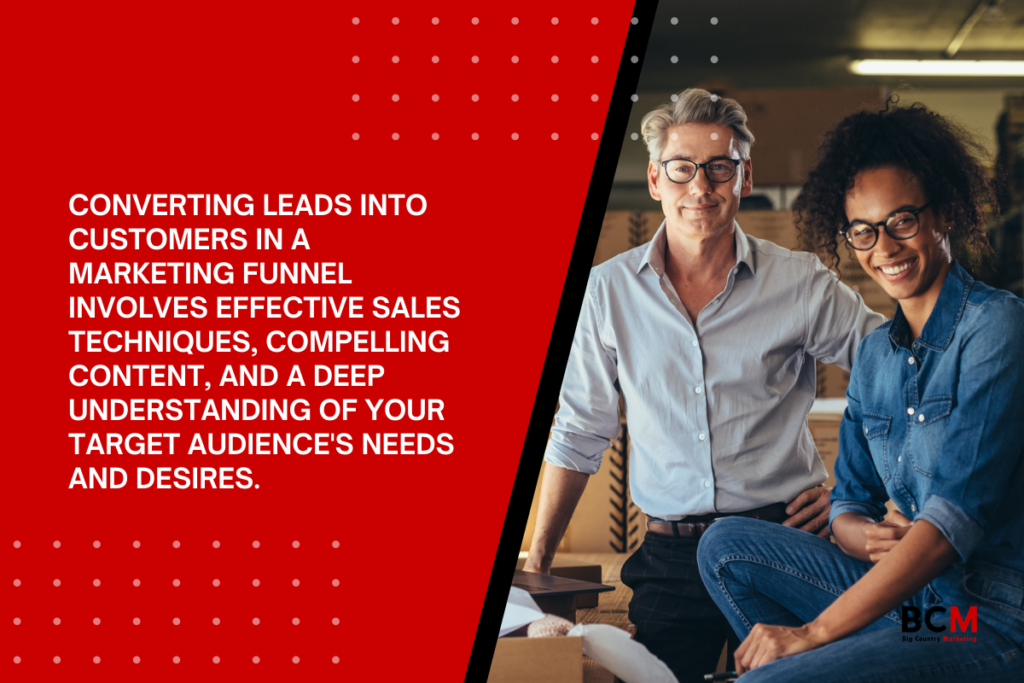
In essence, converting leads into customers in a marketing funnel is a delicate dance of persuasion, engagement, and understanding. It’s about creating a customer journey that feels personal, valuable, and ultimately leads to a decision in your favor.
What Are Some of the Top Tools to Help Build Marketing Funnels for My Small Business?
Building a marketing funnel can be a complex task, but thankfully, there are numerous tools available that can simplify the process and improve results. These tools can help you design and optimize your marketing funnel, track customer behavior, increase leads, and achieve higher conversion rates.
HubSpot: HubSpot is a comprehensive marketing, sales, and service software that helps businesses attract visitors, convert leads, and close customers. It offers a free version that includes basic marketing funnel features, making it a great option for small businesses on a budget.
ClickFunnels: A well-known funnel tool that’s geared specifically toward helping businesses create and refine marketing funnels. ClickFunnels is easy to use and has detailed help content for guiding users through each step of the marketing funnel process .
PlusThis: This toolkit automates many marketing processes, including marketing funnels. It helps your team create, publish, and promote content, and build your brand. PlusThis is fairly economical, especially for smaller organizations just starting with their marketing funnel design.
Hotjar: Hotjar provides insights into how customers behave on your site, giving you a clear understanding of what they need and how they feel. It offers Heatmaps, Surveys, Feedback, and Recordings tools that help you understand your customers’ journeys and how they interact with your site.
Kajabi: A SaaS-based platform that helps you generate interest in your product or service and convert it into sales and new customers. Kajabi offers built-in shopping carts, email reporting, and customized promotional offers. They also offer marketing funnel templates that help your team get started.
Systeme.io: An all-in-one marketing software tool for online businesses that includes a funnel builder, dropshipping services, an autoresponder, and business automation. It lets you consolidate all your marketing tools into one platform.
Zendesk Sell: Primarily targets customers who need to create sales funnels, but the tool is also capable of helping your team create and manage your marketing funnels. As a CRM platform, it helps you get full pipeline visibility and contextualize which stage of your marketing funnel your users are at.
Robot Funnel: Robot Funnel is an AI-powered tool that aims to supercharge your sales funnels. It leverages the latest AI advancements to help you take full advantage of your marketing efforts.
Funnelytics: Funnelytics is a sales funnel mapping software that’s highly recommended for marketers and online business owners. It offers great features for funnel visualization, making it easier for you to plan and implement your marketing strategies.
These tools can help you design an effective marketing funnel, move customers more quickly and efficiently through the funnel, optimize your customer experience, measure the success of your funnel with metrics and insights on customer behavior, increase leads, and get higher conversion rates.
Remember, the tools you choose to help you implement your marketing funnel will depend on where you are in the process of setting up your website and marketing funnel.
Some tools offer a complete solution, helping you create a marketing funnel and design web pages relevant to each stage of the customer journey. Others are best for businesses that already have a website and marketing funnel in place, and need data on how well it’s performing so they can optimize their marketing funnel and find out where there might be gaps.
What Pitfalls Should I Avoid When Building a Small Business Marketing Funnel?
Building a marketing funnel is a crucial step for small businesses aiming to convert potential customers into loyal ones. However, the process isn’t without its pitfalls. Here are some common mistakes to avoid:
1. Undefined Target Audience
Before you start creating a marketing funnel, it’s essential to define your target audience1. Attempting to appeal to everyone can lead to wasted resources and ineffective strategies. Focus on a specific group and tailor your funnel to their needs.
2. Lackluster Content
Content is the backbone of your marketing funnel. It needs to be compelling, informative, and valuable to your target audience1. Interactive content such as quizzes, surveys, and calculators can boost engagement and provide valuable insights about your audience.
3. Absence of Incentives
Offering irresistible incentives can expedite the movement of potential customers through your funnel1. This could be a discount, a free trial, or anything else that would entice them to take action.
4. Complicated Conversion Process
Once a potential customer reaches the bottom of your funnel, the conversion process should be straightforward and quick1. A confusing or lengthy checkout process can deter customers.
5. Neglecting to Track Results
Tracking your results is crucial to understanding the effectiveness of your marketing funnel1. Use analytics tools to monitor how people interact with your funnel and make necessary adjustments.
6. Forgoing Split Testing
Split testing allows you to compare different versions of your funnel and optimize for maximum conversion rate1. Without it, you won’t know if your funnel could be performing better.
7. Failing to Follow Up
Following up with leads is essential for nurturing relationships and encouraging repeat business1. Stay in touch with your customers by sending helpful emails, exclusive deals, and updates on new product launches.
By avoiding these common mistakes, you’ll be on your way to creating a successful small business marketing funnel that effectively converts leads into loyal customers.
Cool. So Now How Do I Implement a Marketing Funnel for My Small Business?
Implementing a marketing funnel for your small business is a strategic process that requires careful planning and execution.
Here’s a step-by-step guide on how to do it:
Step 1: Understand Your Customer Journey
Before you can implement your marketing funnel, you need to understand your customer journey. This involves identifying the different stages your customers go through before making a purchase. These stages typically include awareness, consideration, conversion, and loyalty.
Step 2: Define Your Goals
Next, define your goals for each stage of the funnel. What do you want to achieve at the awareness stage? How about the consideration stage? Your goals will guide your strategies and help you measure the success of your funnel.
Step 3: Choose the Right Tools
There are various tools available that can help you build and manage your marketing funnel. These include CRM software, email marketing tools, and analytics tools. Choose the ones that best fit your needs and budget.
Step 4: Create Your Content
Content is key in a marketing funnel. You need to create engaging and valuable content that will attract your target audience and guide them through the funnel. This could be blog posts, videos, ebooks, webinars, or social media posts.
Step 5: Promote Your Content
Once you’ve created your content, you need to promote it. This could involve SEO, social media marketing, email marketing, or paid advertising. The goal is to reach as many of your target audience as possible and draw them into your funnel.
Step 6: Monitor and Optimize Your Funnel
Finally, you need to monitor the performance of your funnel and optimize it as necessary. This involves tracking key metrics, analyzing the data, and making adjustments to improve performance.
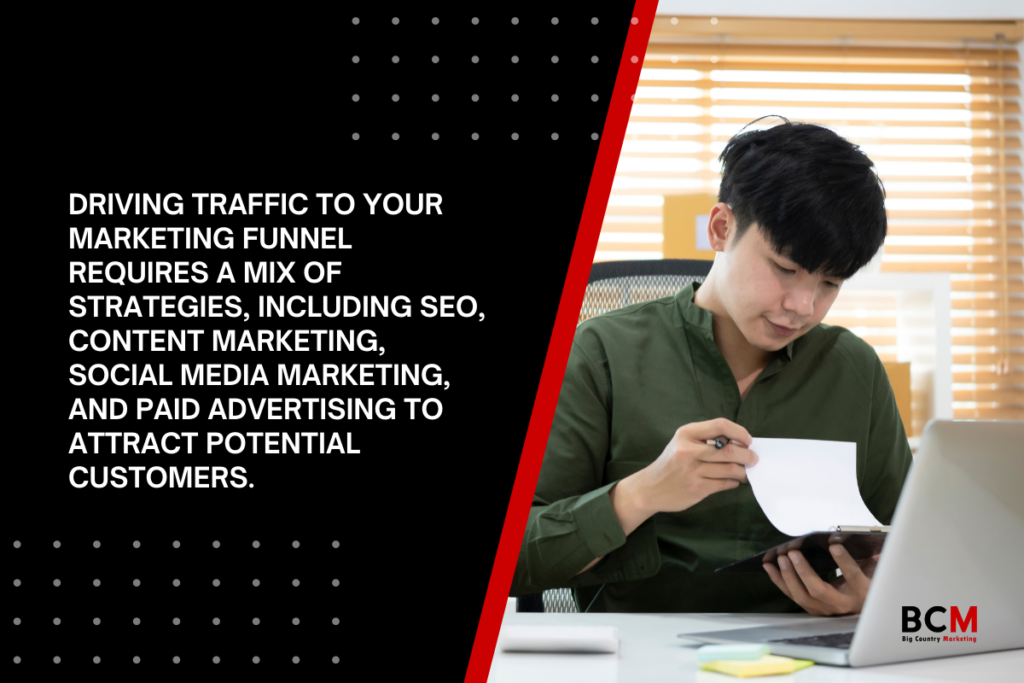
Remember, the key to driving traffic to your marketing funnel is to use these strategies in harmony, creating a balanced and comprehensive marketing approach that caters to your target audience at every stage of their buying journey.
Remember, implementing a marketing funnel is not a one-time task. It’s an ongoing process that requires continuous monitoring and optimization. But with the right approach and tools, you can create a marketing funnel that drives growth and profitability for your small business.
How Can I Measure the Success of My Small Business Marketing Funnel?
The success of your marketing funnel is not just about the number of sales you make. It’s about understanding how well your funnel is working at each stage, and making improvements where necessary. This is where key metrics come into play.
Key Metrics to Track
According to a source, funnel metrics are a series of KPIs that track and measure the volume, velocity, and conversion rates of customers, revealing the effectiveness of your team’s marketing and sales efforts.
Here are some of the key metrics you should be tracking:
Awareness Stage Metrics: These could include website traffic, social media followers, and impressions. The goal here is to measure how well you’re attracting potential customers.
Consideration Stage Metrics: These could include email open rates, click-through rates, and time spent on your website. The goal here is to measure how engaged your potential customers are with your content.
Conversion Stage Metrics: These could include sales, conversion rates, and average order value. The goal here is to measure how well you’re turning potential customers into actual customers.
Loyalty Stage Metrics: These could include repeat purchases, customer lifetime value, and customer retention rates. The goal here is to measure how well you’re retaining customers and encouraging repeat business.
Remember, the key to successful measurement is not just tracking these metrics, but analyzing them and using the insights to improve your marketing funnel. As the saying goes, “What gets measured gets improved.”
How to Analyze These Metrics
Analyzing these metrics involves looking at trends over time, comparing your performance to industry benchmarks, and identifying areas for improvement. For example, if your email open rates are lower than the industry average, this could indicate a need to improve your email subject lines or segmentation strategy.
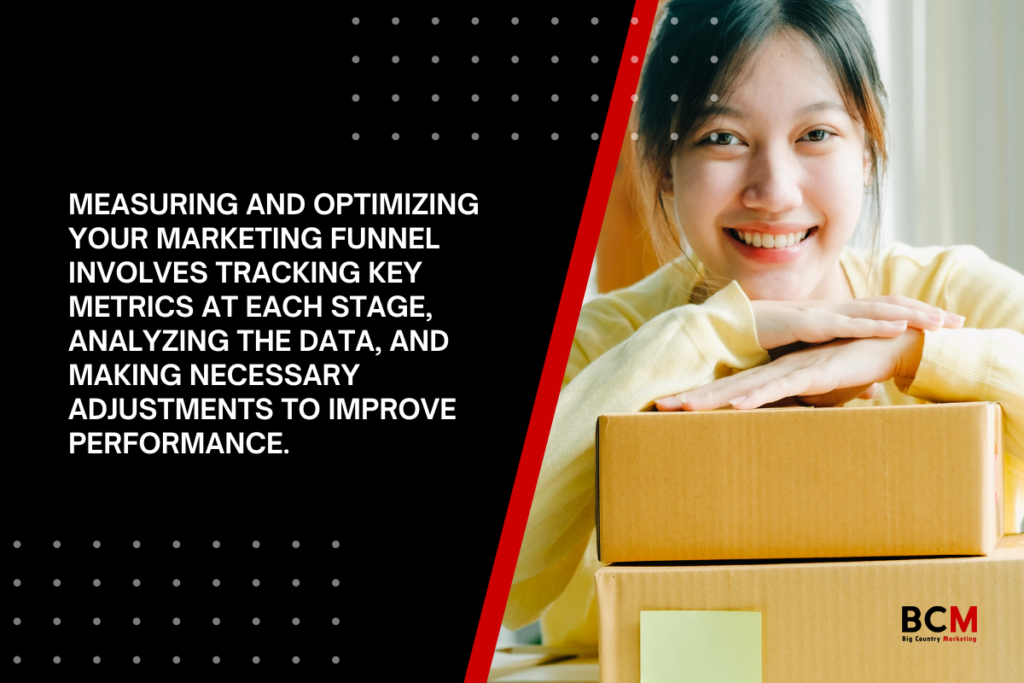
The process of measuring and optimizing your marketing funnel is a continuous, iterative process that requires careful attention to key metrics at each stage of the funnel. This involves not just passive tracking, but active analysis and interpretation of the data you collect.
In conclusion, measuring the success of your marketing funnel is a crucial step in optimizing your marketing efforts and driving growth for your small business. So, start tracking these metrics today, and watch your business grow!
Wrapping Up: A Final Word on Mastering Small Business Marketing Funnels
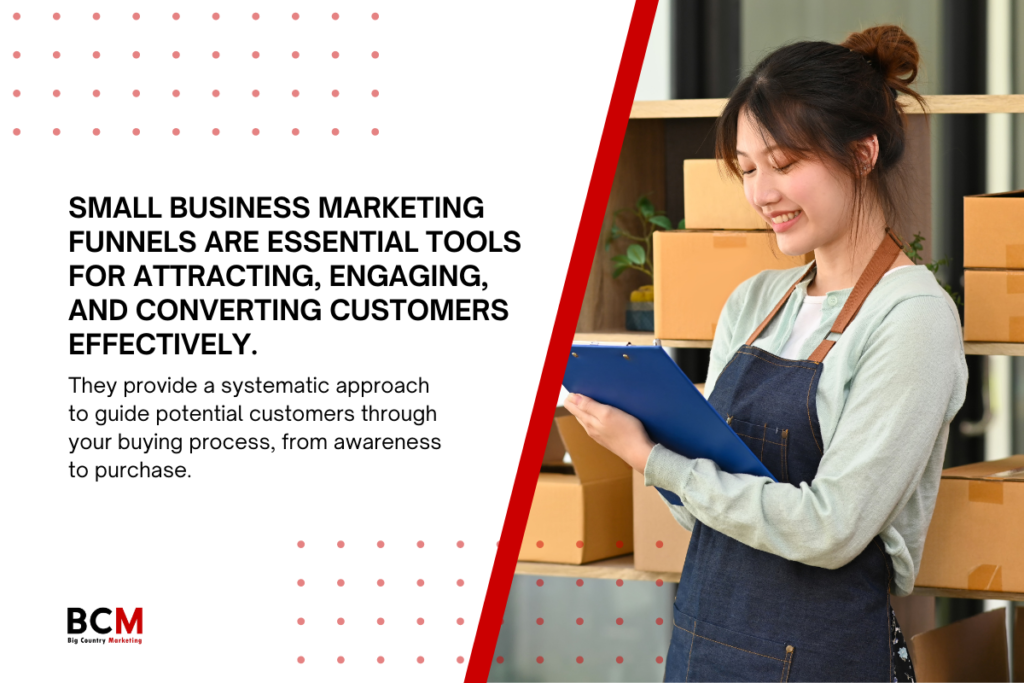
Congratulations! You’ve taken a deep dive into the world of small business marketing funnels. You’ve learned what they are, why they’re crucial for your business, and how to build, implement, and measure their success. But remember, knowledge is only powerful when it’s applied.
So, what’s next?
Start by taking a closer look at your current marketing efforts. Where does a marketing funnel fit in? How can you apply what you’ve learned to improve your strategies? Remember, building a successful marketing funnel is not a one-time task. It’s a continuous process of testing, measuring, and optimizing.
As you embark on this journey, keep in mind this quote from marketing guru Seth Godin: “People do not buy goods and services. They buy relations, stories, and magic.”
Your marketing funnel is more than just a tool for driving sales. It’s a way to build relationships with your customers, tell your brand story, and create a little bit of magic that sets you apart from the competition.
And remember, you’re not alone in this journey. We’re here to help you navigate the world of small business marketing. So, why stop here? Check out our other blog posts on small business marketing for more insights, tips, and strategies to help your business grow. Let’s create some marketing magic together!






